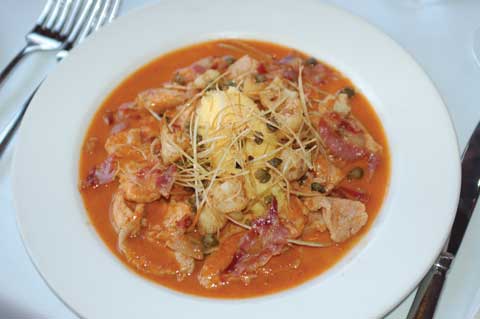



Executive Chef Paul Canales
Oliveto
OAKLAND, CA
INGREDIENTS
[Serves 4]
8 slices pancetta, cut into 1” pieces
8 leaves sage
2 large cloves garlic, finely chopped
4 oz Vin Santo (Italian Dessert Wine)
8 oz pork sugo (see recipe below)
2 oz unsalted butter
20 oz pork coppa or light leg meat, as thinly sliced as possible (less than 1/8th of an inch), but not pounded
As needed salt and pepper for seasoning
METHOD
Place the pancetta and sage in a large sauté pan and warm over medium heat. When pancetta begins to sizzle, raise the heat to high and stir until pancetta begins to brown. Add the garlic and bloom for a few seconds until it gives off its characteristic aroma, then add the vin santo. This will stop the garlic form burning, as well as deglazing the pancetta renderings.
Cook this mixture for about 10 seconds, then add the sugo and the butter. Reduce the sauce by about half; the sauce will become thick, so be careful not to let it dry out completely and separate. If this happens, splash in a little water to re-emulsify the sauce and proceed to the next step. While the sauce is reducing, season the meat with salt and pepper to your liking.
When the sauce is reduced by half, add the seasoned pork and toss with the sauce over high heat until the meat is just cooked through. You will be able to tell when the meat is done as the color changes from light pink and translucent (raw state) to an off-white and opaque. Remove from the heat, taste and adjust seasoning, and serve immediately.
INGREDIENTS [Pork sugo]
[1 quart]
4 oz pancetta, thinly sliced
1 lb chicken legs and or thighs, cut into 2” pieces with a cleaver
2 lb pork leg (dark muscle) or shoulder meat, cut into 1” pieces
1 ½ t salt
½ t black pepper
1 medium red onion, thinly sliced
1 small carrot, thinly sliced
1 medium bay leaf (Mediterranean variety)
3 each cloves
2 quarts meat broth
METHOD
Place the pancetta, chicken, and pork meat in a heavy bottomed sauce pot (14” in diameter by 9” high works best for us in the restaurant) and begin rendering over medium high heat. As the meat renders fat and liquid, raise the heat to high and add the salt and black pepper.
As the liquid begins to evaporate, the meat will begin to brown. At this point, pay close attention to the pot and adjust the heat down to medium. Be careful to stir the pot only to facilitate building the foundation of residues on the bottom of the pot; remember, you are working for the residues stuck to the bottom as opposed to nicely browned meat with a clean bottomed pot.
This initial process should take about 30 minutes, at which time you should add the onion, carrot, bay leaf, and cloves, and reduce the heat to medium low. Continue cooking the mixture until the onions are translucent and the carrots are soft, about 10 to 15 minutes.
Next, begin the deglazing process by raising the heat to high, adding a couple of ladlefuls of broth, and scraping the bottom of the pot with a wooden spoon. As the residues come free, continue cooking over high heat until the liquid begins to reduce to a glaze and form another foundation.
At this point add a few more ladlefuls of broth. Repeat this process two more times. After the final reduction, add the remaining broth, bring to a boil, reduce the heat to low, achieving a very lazy simmer. Cover with parchment paper and cook for about two hours.
To finish the sugo, pass the contents of the pot through the medium dye of a food mill into another pot, taking care to press all the liquid from the solids and scraping any residues from the bottom of the food mill. You should be left with a dry, fibrous mass in the food mill and luxurious, silky sugo in the pot.
While you will have more sugo than you will need for the scallopine, the rest can be frozen. At home, I freeze any leftover sugo in ice cube trays, then reserve the cubes in a freezer bag. This way, I can use as much or as little as I want, depending on what I am making.